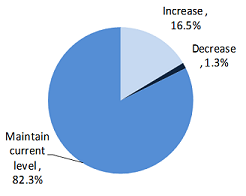Here are some excerpts from previous Protection and Control studies; some of these topics will be revisited in our 2016 survey.
Overall, do you plan to increase, decrease or maintain current levels of capital investment for relay testing equipment, software and training?
The overwhelming majority of the 2012 sample indicated that they plan to maintain their current CapEx levels for these activities. Sixteen percent said they would increase expenditures, and only one respondent indicated a decrease in CapEx. The 2009 findings had indicated that 70% of the respondents would maintain their 2009 level of investment in relay test equipment. Fifteen percent planned to increase such investment, while only eight percent planned a decrease.
Do you plan to rely more on third party services for relay testing?
 In 2012, 20% of responding utilities said they plan to rely more in the coming three year period (2012-2014) on third party relay commissioning and testing services. One person mentioned that due to manpower shortages, they do not have enough personnel available to do testing as well as regular line work.
In 2012, 20% of responding utilities said they plan to rely more in the coming three year period (2012-2014) on third party relay commissioning and testing services. One person mentioned that due to manpower shortages, they do not have enough personnel available to do testing as well as regular line work.
In 2009, only twelve percent had planned to use third party relay testing services. Nearly 25% of the 2006 survey sample indicated that they would be likely to rely more heavily on third party relay testing services. The 2009 cutback in spending for third party services may well have been due to the impact of the recession, and the significant erosion of CAPEX and OPEX spending in that year.
Do you operate a Wide Area Network (WAN) for remote access to relays?
Fifty-three percent of utility respondents overall said they operate a WAN for remote relay access. Surprisingly, 71% of investor owned utilities said they do not operate a WAN for remote access.
How do you operate a Wide Area Network (WAN) for remote access to relays?
Of the 42 utilities in the sample that operate a WAN, 71% operate the WAN via serial port terminal servers or data concentrators, and 62% indicated they operate the WAN through firewalls. Almost all utilities had a multi-pronged approach to operating their WANs.
For more information on the forthcoming update to the worldwide study of the protective relay marketplace, call 1 410 465 7316 or send an email inquiry to info@newton-evans.com

 summary reviews and highlights from completed studies
summary reviews and highlights from completed studies
